On the last afternoon in the Tsaranoro Valley close to the Andringitra Massif in central Madagascar, Sneža and I went on a casual walk to the nearby cascades. The road took us over a dam that was made across that same river which also served as a bridge for crossing on foot from one riverbank to the other.
The top of the dam was not too narrow at all and there were no problems in that sense. But, the water ran over most of the dam and in places it was a little slippery, while the two of us were worried we could fall into the water with our photo-cameras and/or mobile phones.
When I got to a dry patch, I took advantage of my stability, turned around and took a photo of Sneža. I also took photos of the landscapes in front of me.
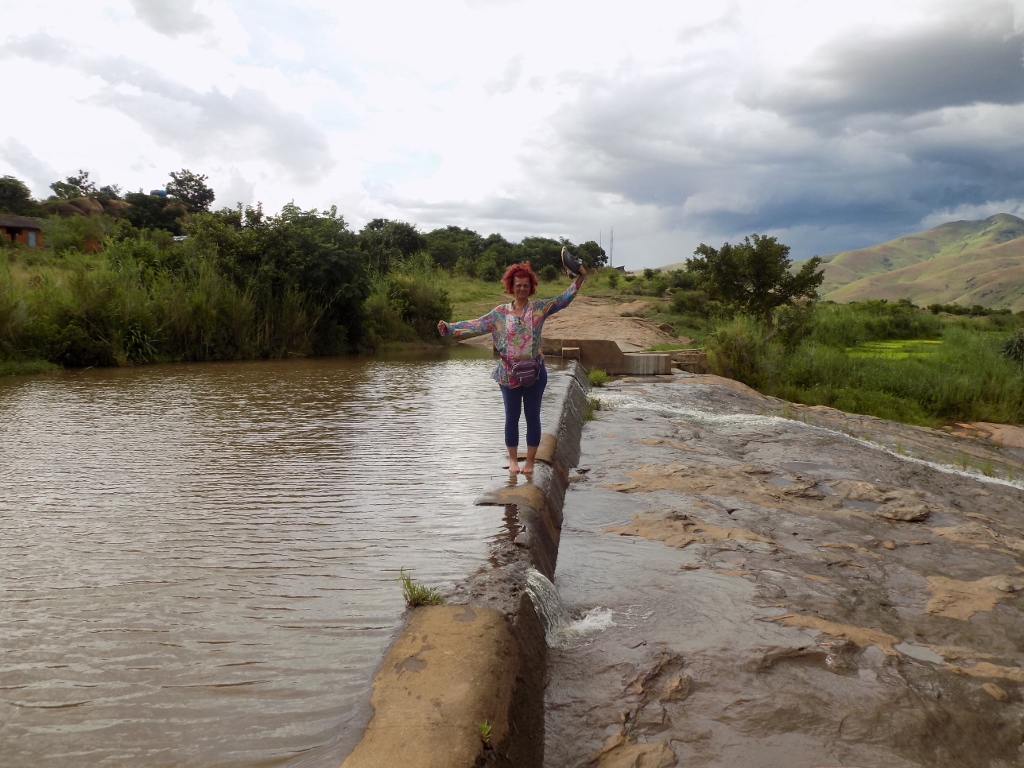 Sneža on the dam
Sneža on the dam
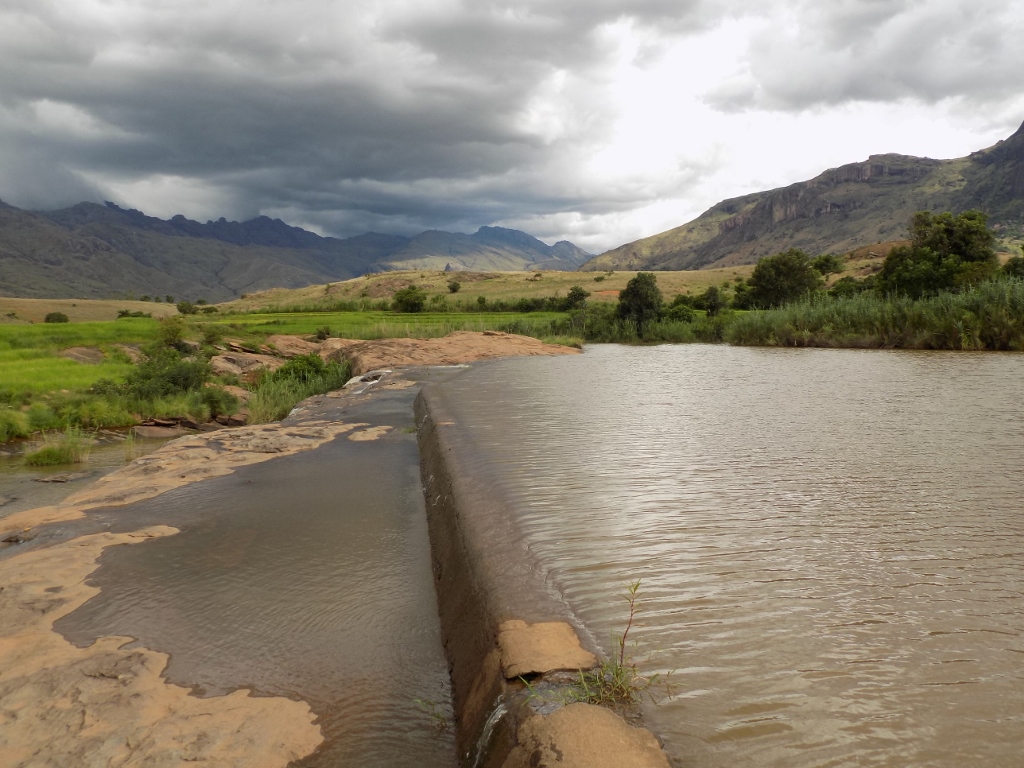 The dam in front of me
The dam in front of me
We advanced a little bit more and then at the end of the dam, before the other riverbank, since the dam did not go all the way to the end, I saw something like a cascade that flowed over some rocks. That segment was not too wide, but it was not sufficiently narrow for me to cross it in one step, plus I was also aware that the water flowed faster there and I already saw in my mind’s eye the images of slippery rocks that I should step on with not too steady a foot, ... I’m generally not too easily scared and do not shy away from challenges, even less from bathing, but in the bag around my waist I had my mobile phone and the camera – two very important devices, especially on a journey around a far-away country. Sneža found herself in a similar situation and the frame of mind. So, we had an agreement – turn around and go back to where we came from.
While we were putting our shoes back on at the place where a few minutes earlier we had taken them off, a local man came who quite leisurely used the top of the dam to cross from one side of the river to the other. We wondered if perhaps we made an error in judgment and if we simply chickened out, but still we were not ready to try it again.
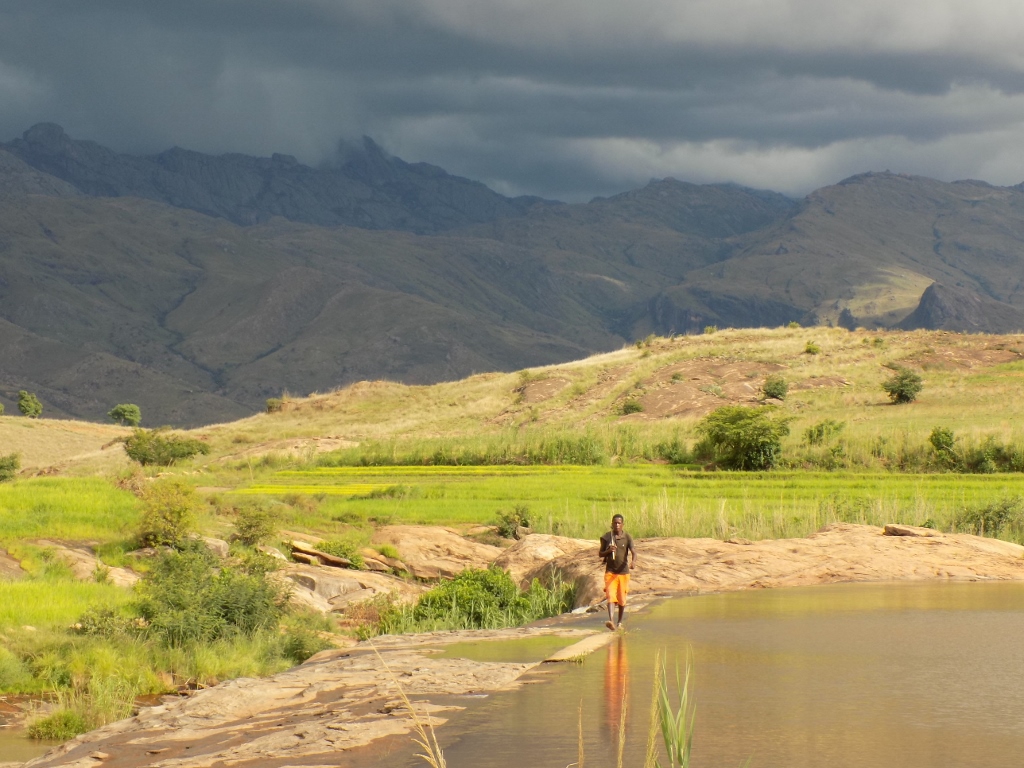 When people have the experience, walking over the dam is a piece of cake
When people have the experience, walking over the dam is a piece of cake
Meanwhile, already during that short period between our attempt to cross to the other side and the arrival of that young man, the clouds started to get darker and darker above the Andringitra Massif from where they were heading in our direction. Admittedly, the Sun still managed successfully to shine from the other side, making the contrast even more pronounced, and I constantly heard in my head the resonating of the word “dramatic” as the true description of those celestial changes I witness with my eyes wide open in an attempt to let as much of that beauty as possible flow into my soul and my memory. The photographs certainly may help a little in this.

To Sneža’s and my defence, the photo below shows nicely this section that had to be crossed by walking over the stones and that is located between the dam and the large rock on the other side. As it can be noticed, it is not negligible.
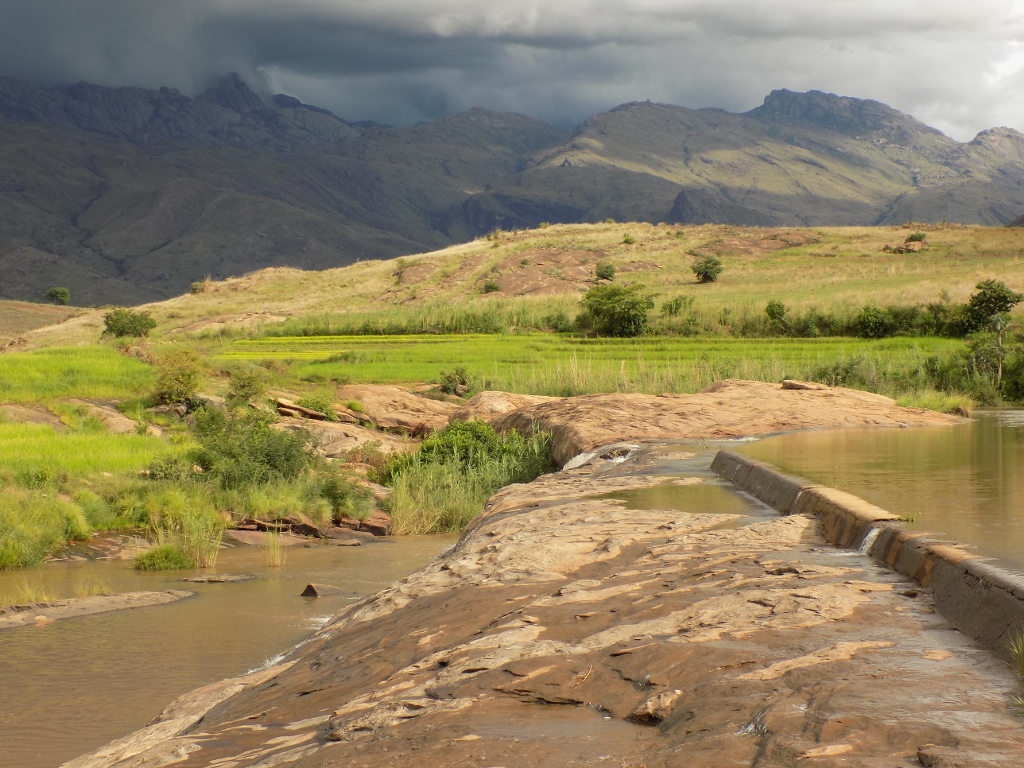 End of the dam
End of the dam
As I was taking the photos of the dam and the surrounding landscapes, another local guy came who continued walking over the dam at the same pace and with the same level of casualness as when he walked along the dry path before the dam. Well, if we had lived there and if we had crossed the dam who knows how many times, we would have also been equally skilful.
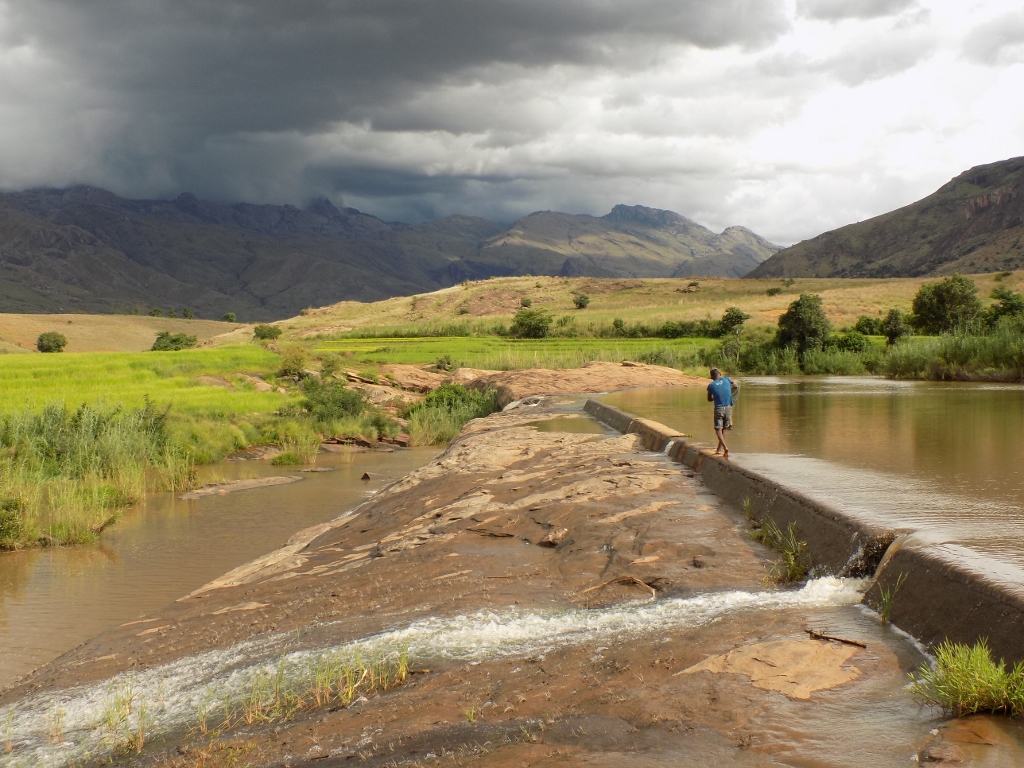 This is obviously a very frequently used “traffic route”
This is obviously a very frequently used “traffic route”
As a kind of a comfort, on our way back I noticed yet another specimen of that big colourful locust from Madagascar, the Rainbow Milkweed Locust (Phymateus saxosus) and I did it without any help of any guide which made me very proud. Admittedly, this locust was around 7-8 cm long and was indeed VERY colourful, so it was not that difficult to notice it in the vegetation that was not too dense either.
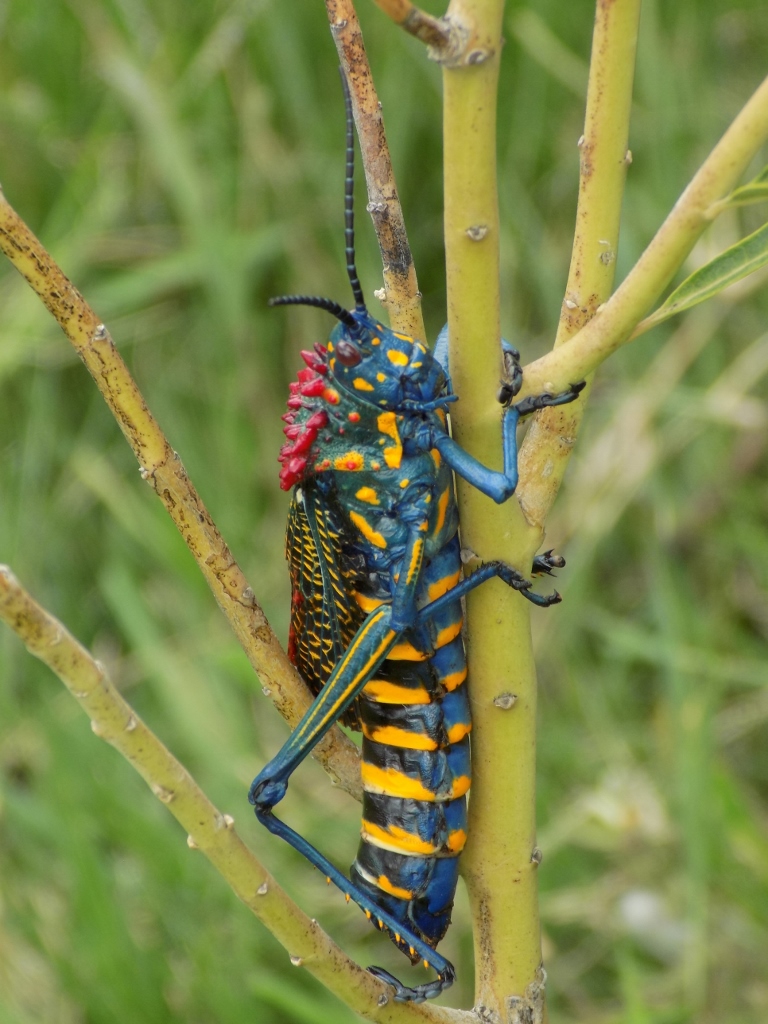 Colourful Rainbow Milkweed Locust
Colourful Rainbow Milkweed Locust
Since we did not manage to get to the large cascades that are located downstream from the camp at which we were staying, Sneža and I walked to another, smaller cascade in the direct proximity of the veranda on which we had spent most of the afternoon.

By the time we got to the small river which in that section, on account of the natural dam in the shape of a large rock, creates a small lake before running off via the cascade into a lower lake, all of a sudden a very strong wind started to blow. The surface of the upper lake which was completely calm just a few seconds before now became visibly rippled.
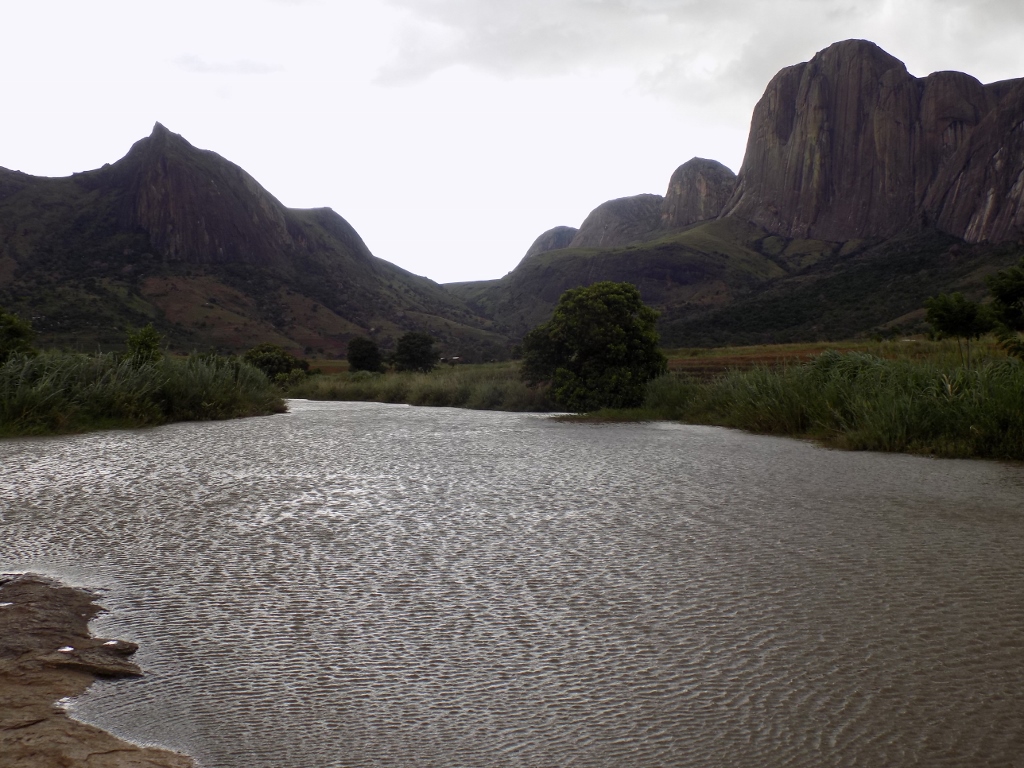 Upper lake with Mount Chameleon and Mount Tsaranoro in the background
Upper lake with Mount Chameleon and Mount Tsaranoro in the background
The wind that started to blow was strong enough that it almost moved us, so we concluded that it was in fact an excellent thing that we did not walk over the other dam and that we did not go to the big cascades, since the tempest that was obviously starting would have certainly caught us somewhere along the way on our return. So, we just made a few photos and went back to the restaurant and the veranda.
Looking back towards the rock, the cascade and the Andringitra Massif in the distance I was again completely amazed by how the light, the colours and the shadows changed quickly all thanks to the different clouds brought by the wind.
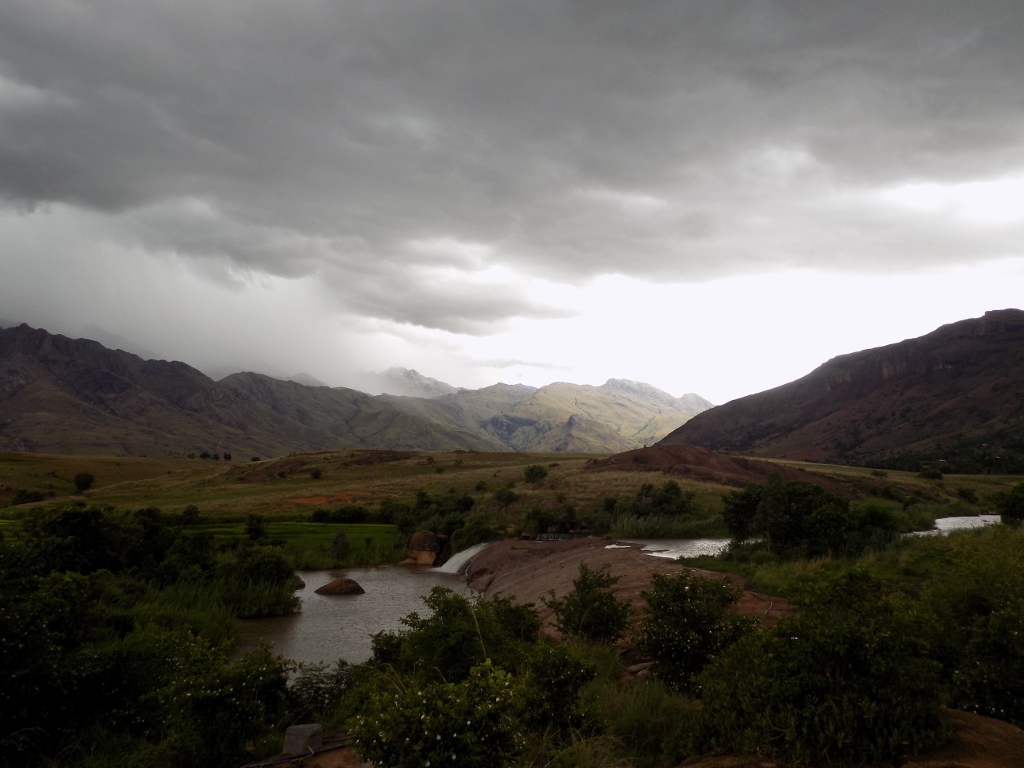 Just a few minutes earlier, the colours were completely different
Just a few minutes earlier, the colours were completely different

While taking photos of these scenes, I was absolutely fascinated by those spectacular landscapes filled with incredibly strong feelings of inner content, happiness and gratefulness for having the privilege to be surrounded by such beauty. I was woken up from that state of exaltation by raindrops and I moved to the veranda that was well covered.
Soon the sky opened, the rain poured and it lasted and lasted. Uniformly gray clouds and rain gradually covered the parts I had admired just until a little while before, so very soon I could not discern any part of the mountains, only a few houses that were separated from where I was standing by a wide section filled with rice fields. After a few minutes more, even those houses could no longer be seen because of the rain. The experience was fascinating!
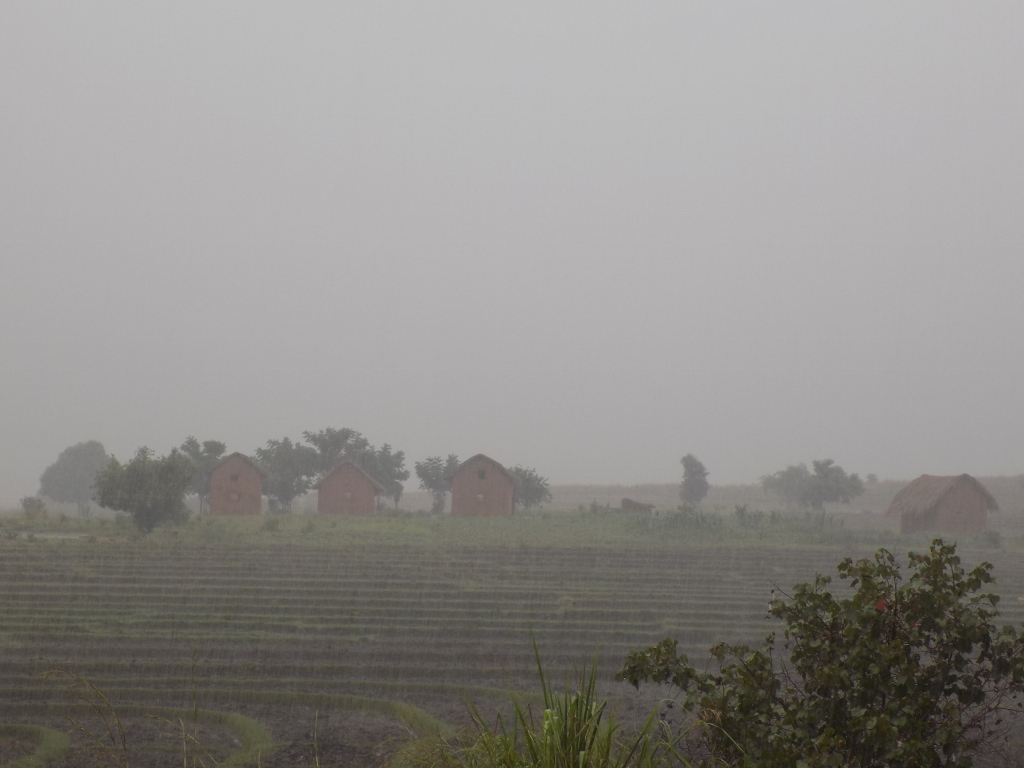 The rain is slowly hiding the landscapes
The rain is slowly hiding the landscapes
Like mesmerised, I watched that force of nature in action only making sure that I positioned my armchair in such a way as not to be wetted by the occasional waves of rain which gusts of wind forced under the roof of the veranda. When I finally managed to convince myself to pull away from watching the events on the side of the veranda where I was sitting, I went to the other side where the path was which connected the tents within the camp and the restaurant section. It still rained heavily and I wondered how the two of us would get to our room if it did not stop and whether the ground along the path was too soft or slippery for safe walking.
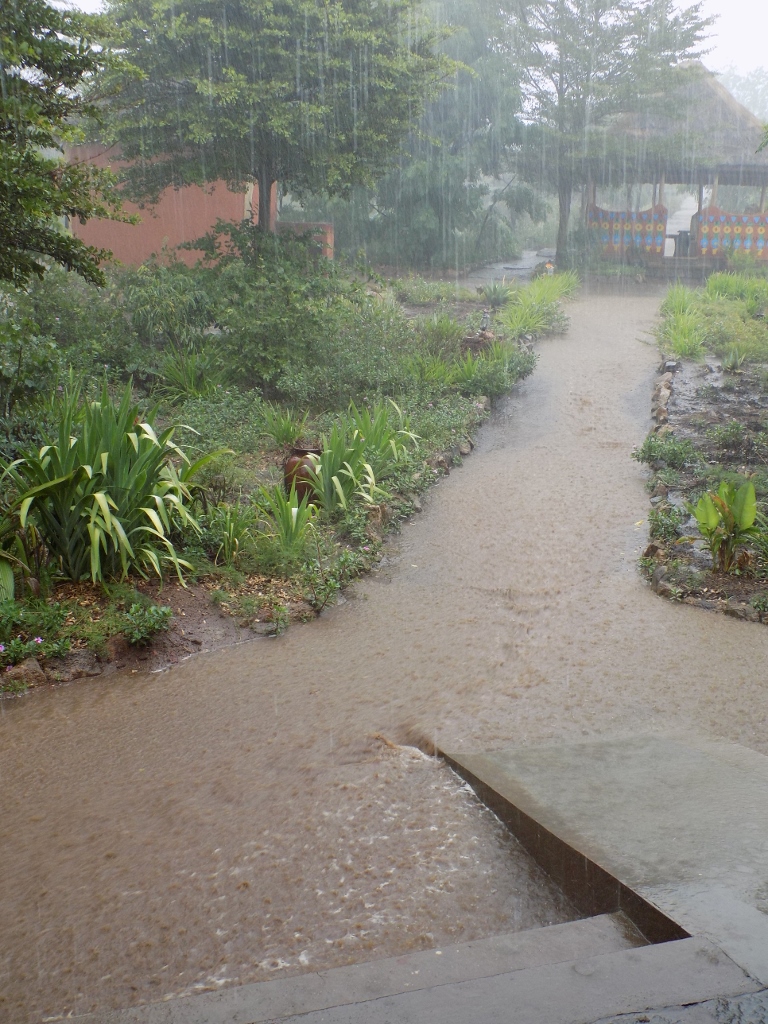 Where there used to be a normal dry path before, there was a stream now
Where there used to be a normal dry path before, there was a stream now
Still, at some point the rain started to slow down. It would occasionally even turn into light drizzle, although it did not stop completely that entire evening. I used those moments to take some more photos of the Andringitra Massif since it was now freshly washed, while the clouds of different density and nuance of gray still moved dramatically between the heights of these mountains.

When the night started to fall, we moved from the veranda into the restaurant where again we had very tasty dinner. Among other things we ate zebu meat, while for the desert we had flambéed fresh pineapple in caramel sauce. I guess these were pieces of a pineapple from the garden behind the restaurant. It cannot get any fresher than that.
After the great dinner, we took advantage of a moment when the rain seemed to get tired from all that falling, so we quickly managed to get to our room without getting too wet and we also navigated the path well without getting muddy. The stream made by rain had already flowed away and in the meantime we had learned in which sections of the path the ground was harder and thus better to walk over. Before going to sleep, again I had a shower in that fascinating “shower cabin” where the warm water from the shower head mixed with the pleasantly fresh raindrops thanks to the absence of a roof. It was again an outstanding experience!
Already the next morning, everything seemed much calmer, the Sun was pushing its way through the clouds, although some clouds still persevered around Mounts Chameleon and Tsaranoro.
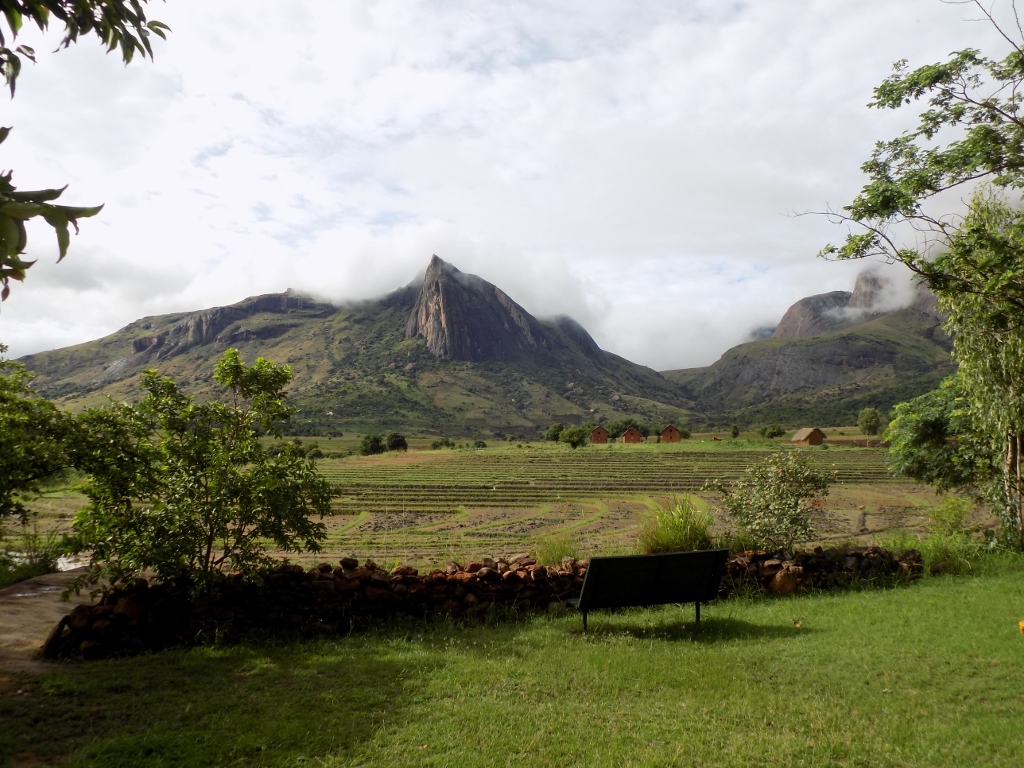 Morning like nothing happened the evening before
Morning like nothing happened the evening before
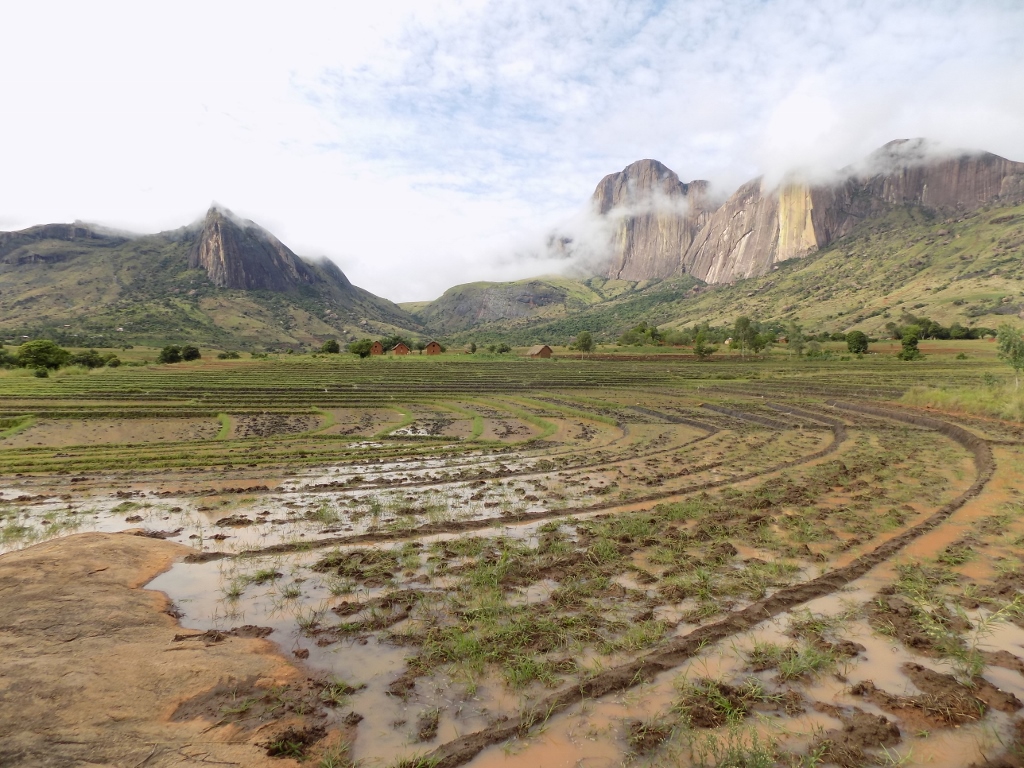 Mount Chameleon and Mount Tsaranoro, and the rice paddies the morning after heavy rain
Mount Chameleon and Mount Tsaranoro, and the rice paddies the morning after heavy rain
Rija, our driver, told us later that it was good that it rained so much since the rainy season was a little late this year and the farmers worried because the earth was very dry. On the other hand, this morning Rija was in no hurry at all. Later he would tell us that the reason was to give time to the thirsty land to soak in as much rain as possible, thus ensuring in this way that there would not be too much mud and too many puddles on the road.
This also gave us a little bit of free time after the breakfast to have another coffee in peace while sitting again on the veranda. While doing that, I noticed a tiny praying mantis which somehow ended up on my skirt.
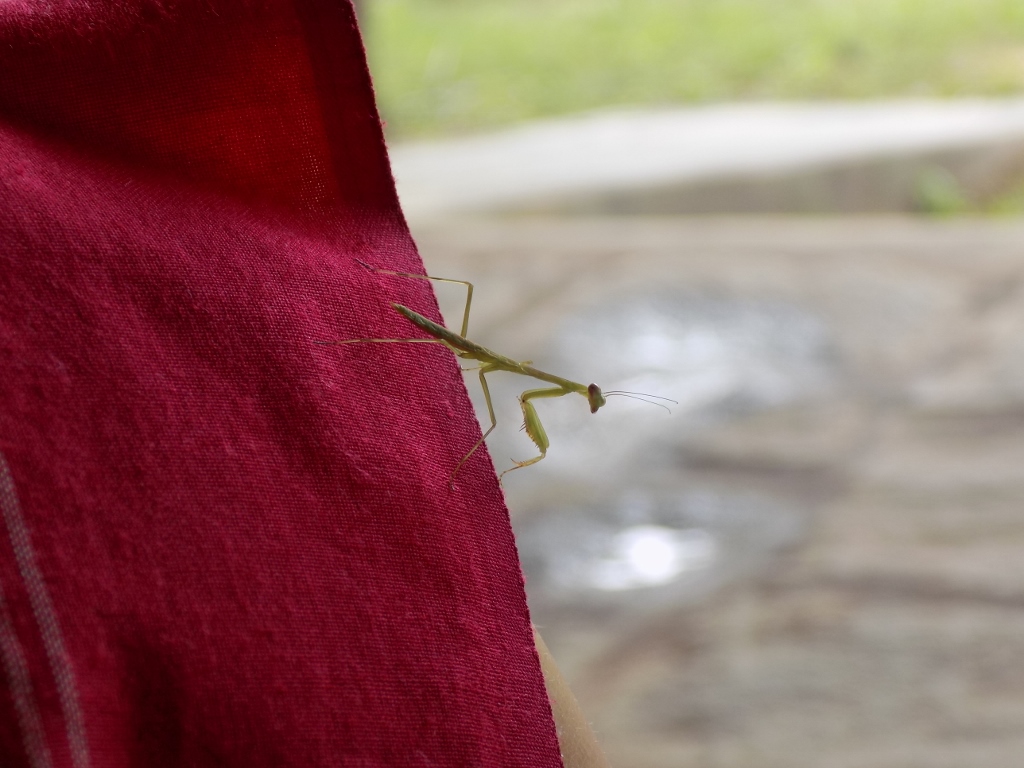 Tiny praying mantis on my skirt
Tiny praying mantis on my skirt
Still, no matter how much we enjoyed the peace and the beauty of the surroundings, as well as the good coffee, the time came for us to move from the camp in the Tsaranoro valley.
Very soon the road took us beside those cascades which Sneža and I wanted to see the afternoon before, so now Rija stopped in order for the two of us to get out of the car and to see them well from the direction of the road.
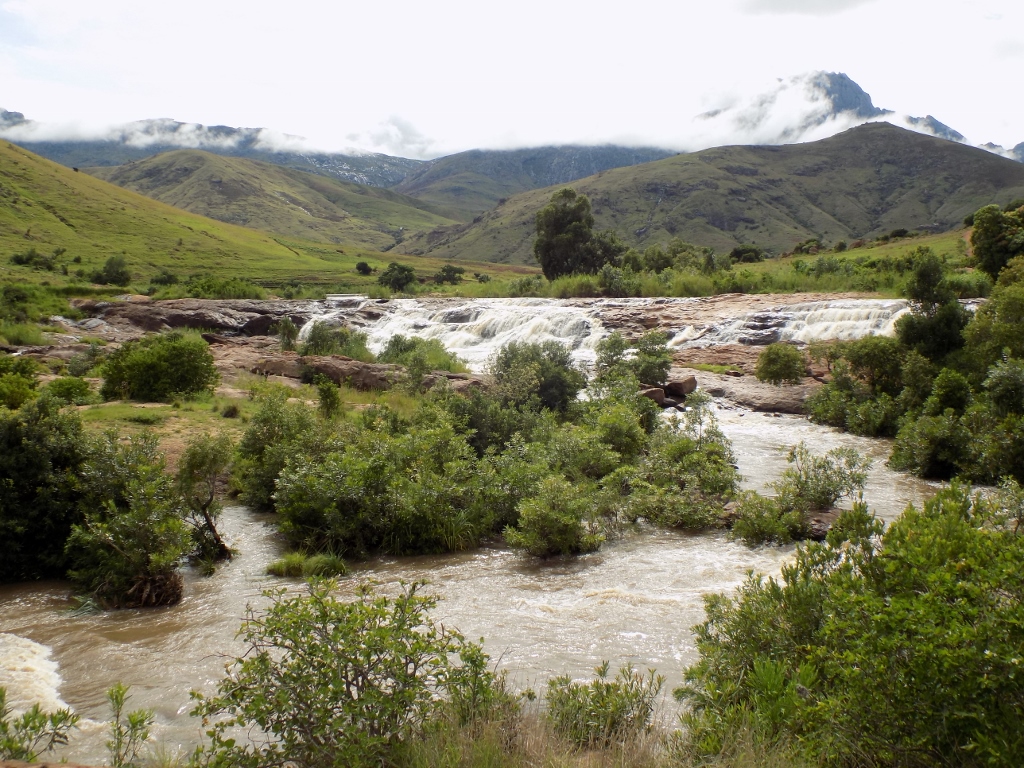 Cascades by the road
Cascades by the road
We actually saw those cascades already the first day when we arrived in the valley, but they were much less conspicuous then since the water level was somewhat lower. Now, after the significant amount of rain that fell the night before, the river was swollen and consequently more water flowed over these rocks.
Nearby I also saw paddies full of young, freshly planted rice, but I’m sure that there was water in these paddies even before the rain, since farmers here know very skilfully and well to bring water from different streams and springs to their fields.
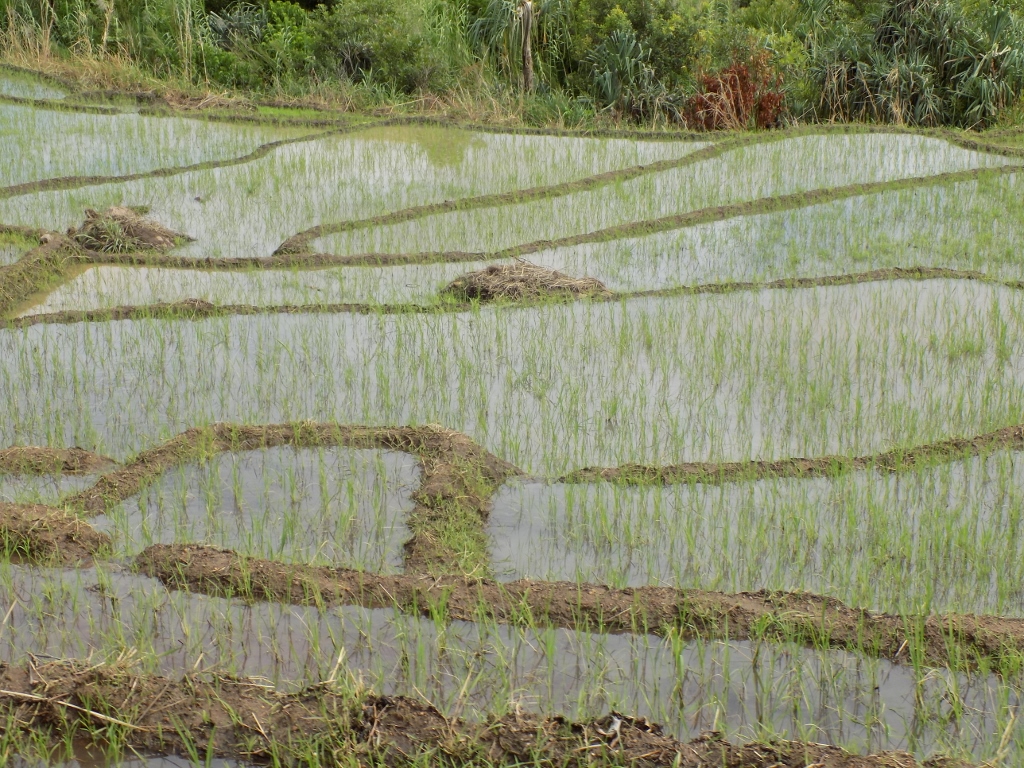 Rice paddies with young, freshly planted rice
Rice paddies with young, freshly planted rice
On the other hand, although there were some clouds still lingering in the sky, the heavy rain was the thing of the past and as the new day dawned the life continued going on in its usual way.
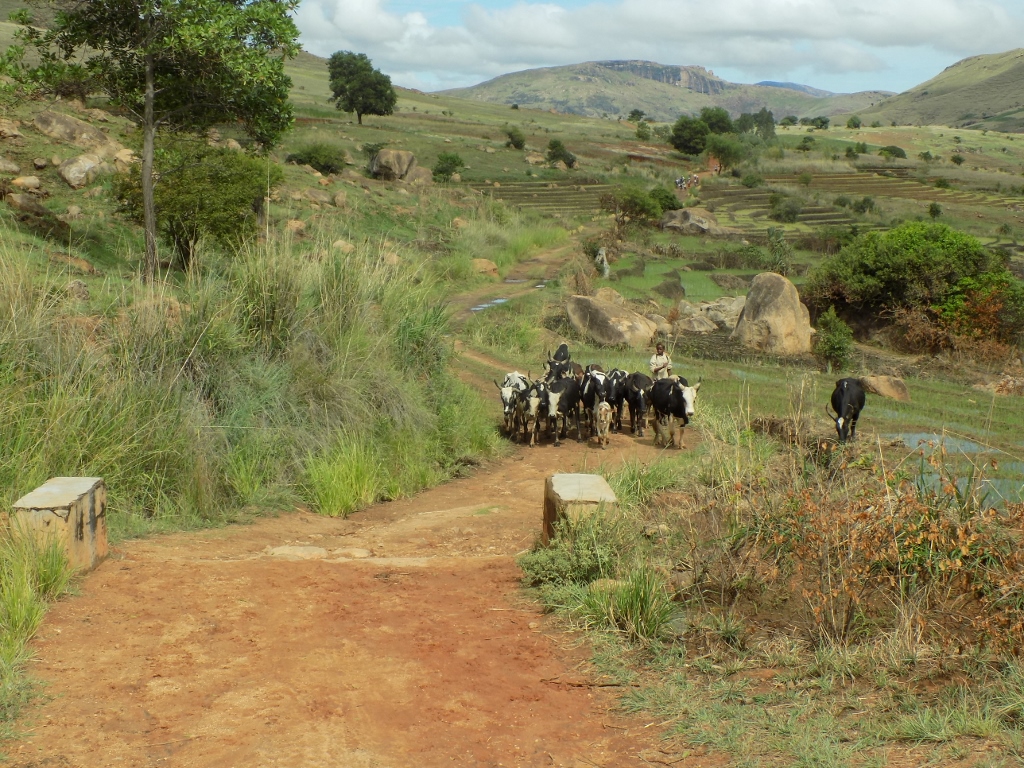 Cowherd with his zebus
Cowherd with his zebus
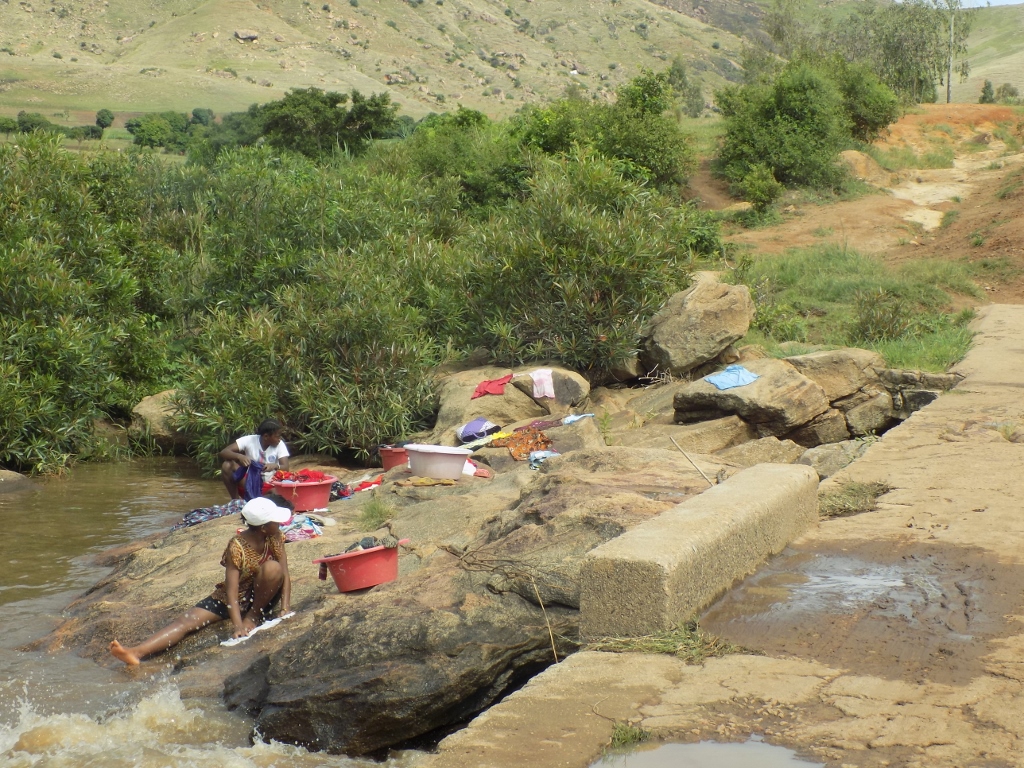 The laundry needs to be washed and the dry and sunny part of the day should be taken advantage of in order for the laundry to dry
The laundry needs to be washed and the dry and sunny part of the day should be taken advantage of in order for the laundry to dry
The dirt road that we needed to take in order to get to the main asphalt road was, of course, no better now than in comparison to a couple of days before when we took it in the opposite direction. The only difference was that this time around there were puddles in several places, but Rija navigated that very successfully.
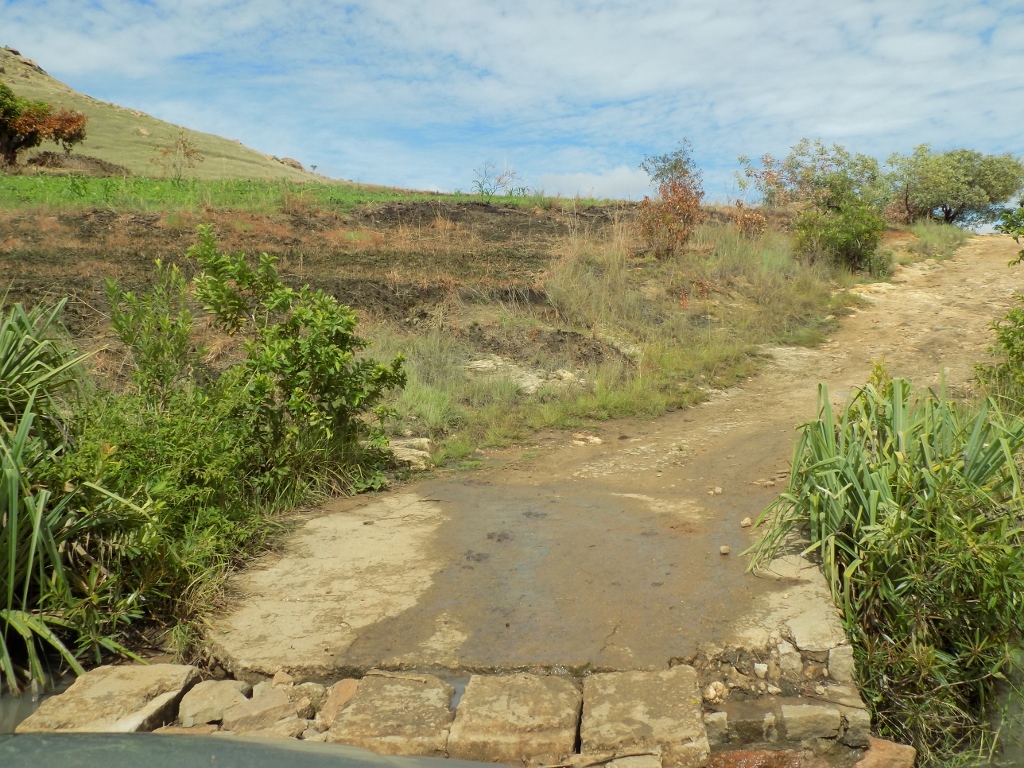 Road from the Tsaranoro Valley to the National Road RN7
Road from the Tsaranoro Valley to the National Road RN7
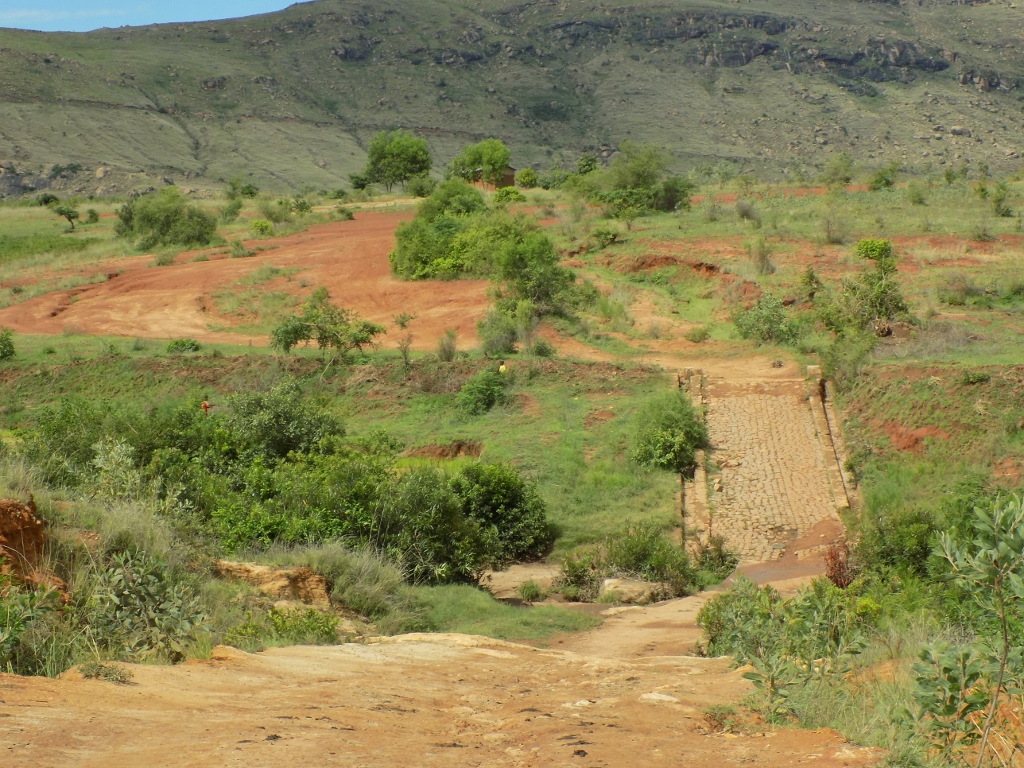 Road from the Tsaranoro Valley to the National Road RN7
Road from the Tsaranoro Valley to the National Road RN7
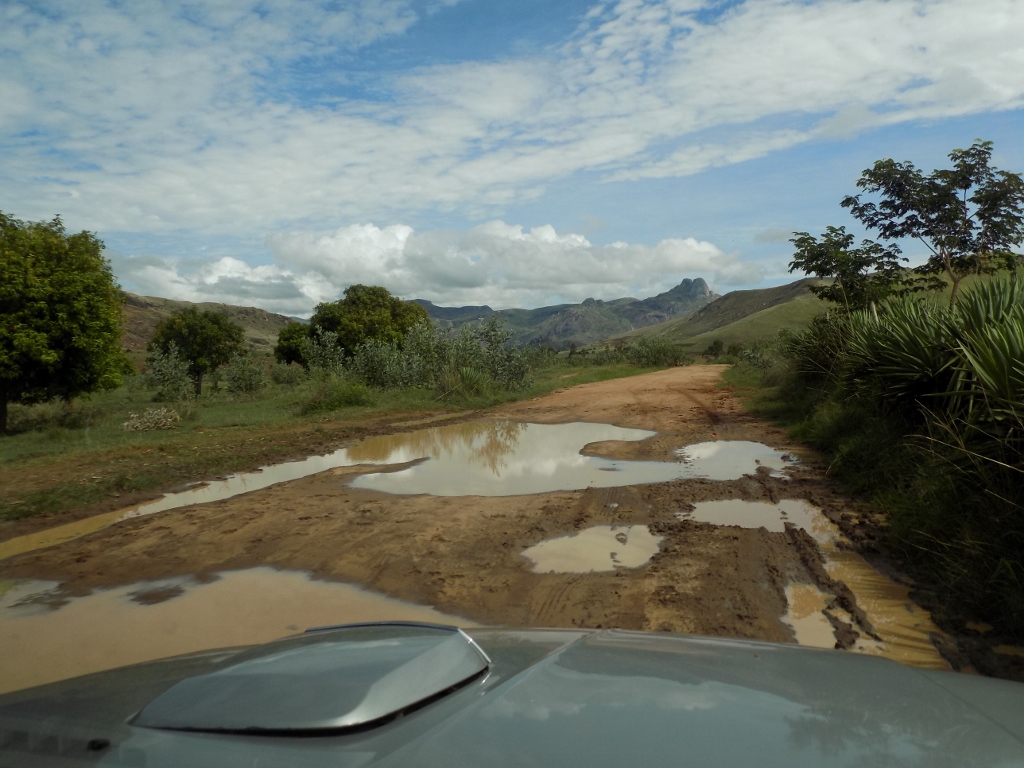 Road from the Tsaranoro Valley to the National Road RN7
Road from the Tsaranoro Valley to the National Road RN7
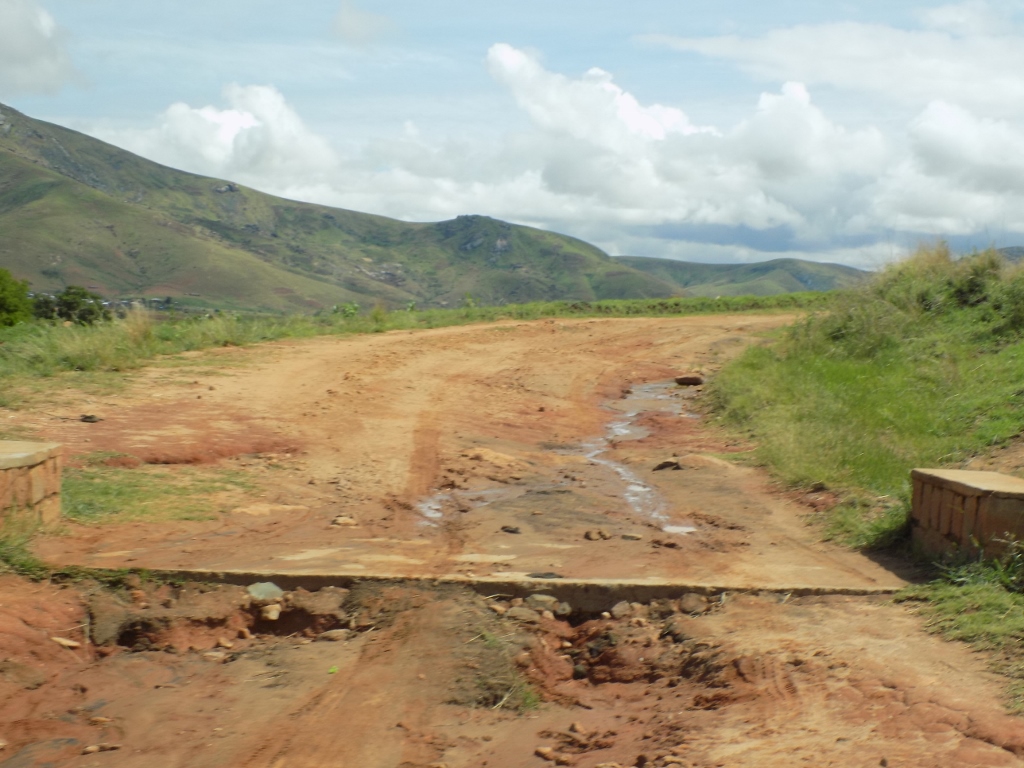 Road from the Tsaranoro Valley to the National Road RN7
Road from the Tsaranoro Valley to the National Road RN7
Along the way I managed to take a photo of a woman, but since the car was jumping all the time the photo is a little blurred and not too good, and yet it is good enough for what I want to say in connection with it. If somebody sometimes thinks that their life is difficult, in terms that they are working too much, let them see this photo and this young woman who carried on her head a bucket that was certainly full, had a child tied to her back, while in both of her arms she also had buckets that certainly seemed full as they pulled towards the ground with their weight.
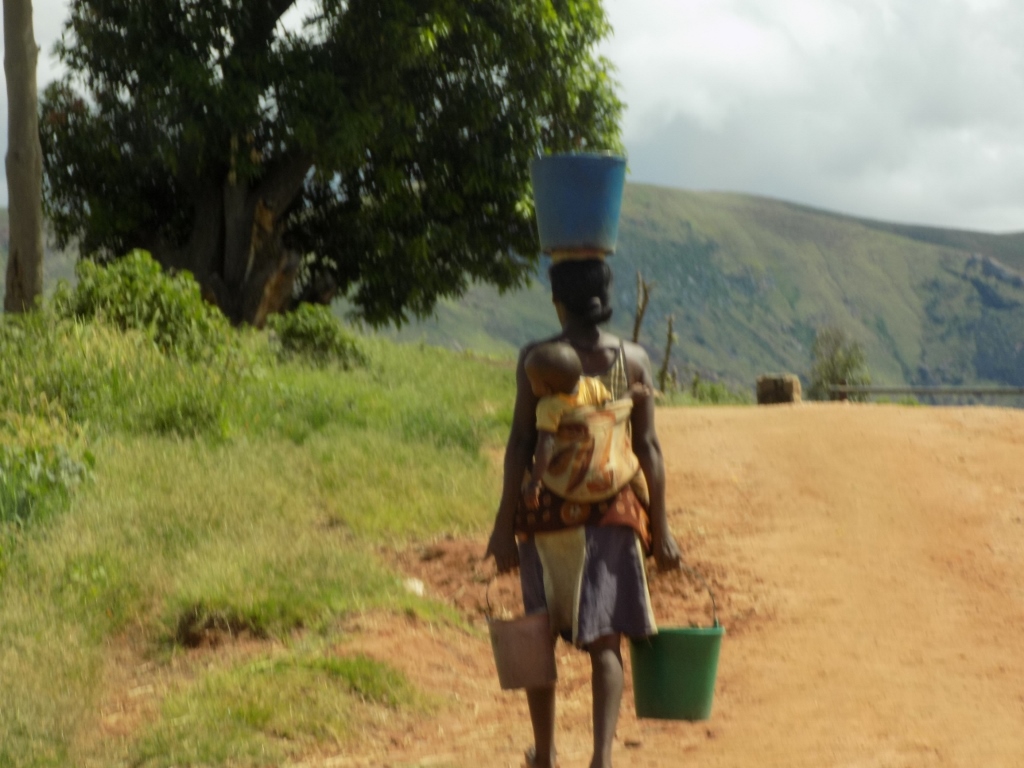 Whenever you think your “back is breaking” from hard work, remember this photo
Whenever you think your “back is breaking” from hard work, remember this photo
After about one hour of Rija’s skilful drive, we reached the main asphalt road and there we continued further with our touring of Madagascar in the direction of the southwest. Along the way we drove from time to time beside improvised stalls where they were selling fruits and vegetables that grow in the numerous fields we could see close to the road.
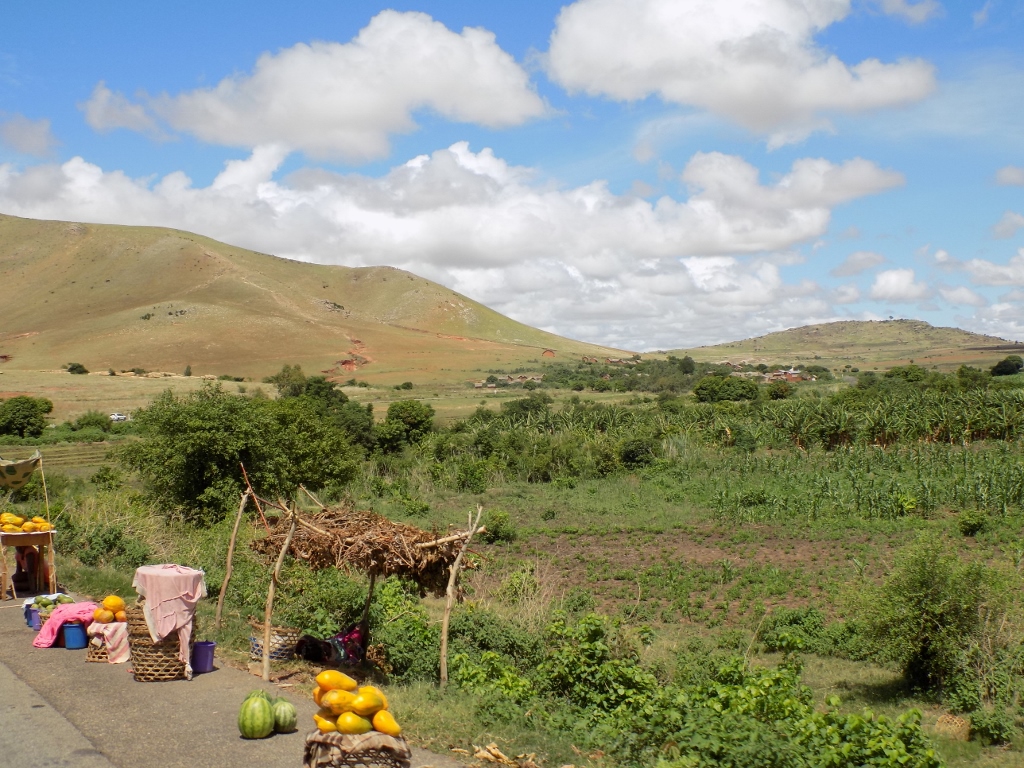 Papayas and watermelons
Papayas and watermelons
After some 30 kilometres driving on the asphalt road, I saw in the distance the impressive Ifandana Rock which peaks at 1052 m above sea level. Because of its rather unusual shape, the local population calls it the “Bishop’s Hat.”
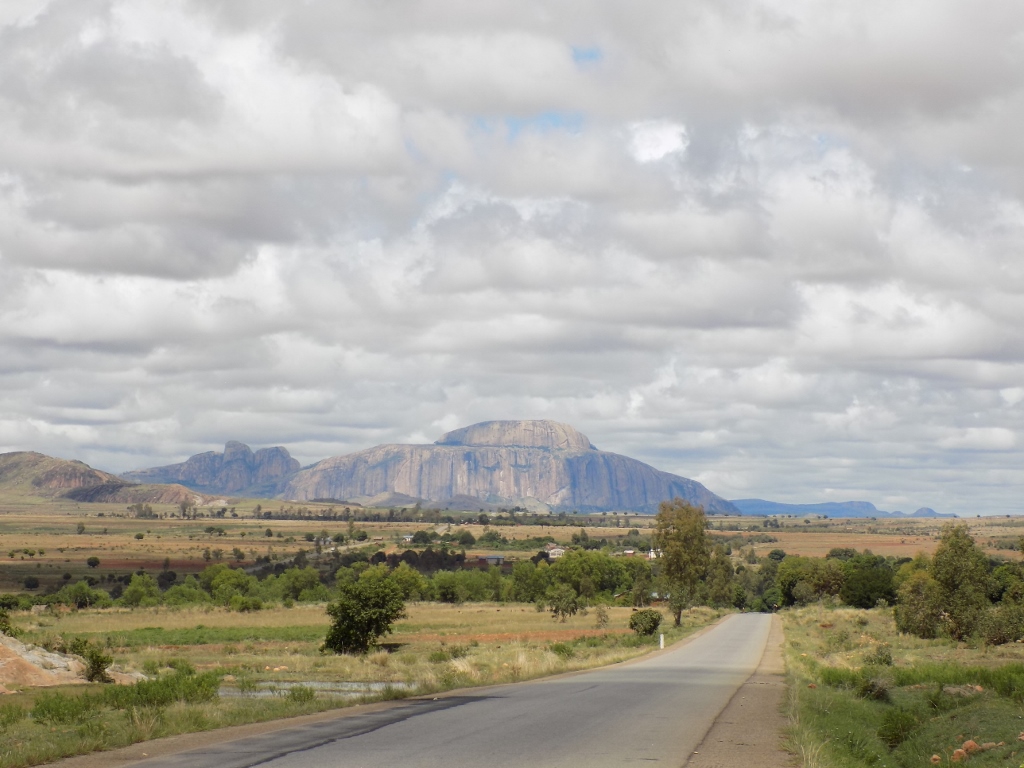 Ifandana Rock
Ifandana Rock
In 1811, Radama I, the sovereign of the Kingdom of Merina (the Merina are the biggest ethnic group that populate the central highlands on Madagascar), decided to subjugate the Betsileo people who were at the time ruled by King Andrianamponolona. The Betsileo people who withdrew to a village above the surrounding plains successfully resisted the attacks for several months, but then came the famine. Facing a certain defeat, many members of the population that had put up the resistance preferred to take their own lives by throwing themselves from the top of the rock into the abyss than to surrender to the conquerors and become their slaves. Those who did not choose this option either died of starvation or indeed ended up as the slaves to the Merina people. It is said that even today it is possible to find human bones at the foot of the rock. Because of all of this, the rock has become highly sacred for members of the Betsileo ethnic group, while at the same time it is prohibited for the members of the Merina ethnic group.


Rija made a stop for us in one spot so that we could make some photos nicely and while we were doing it, several people from a nearby field quickly came to us and there they put a branch down on the road along with its resident – a confused chameleon that probably wondered how he had ended up there on the hot asphalt when just a few moments ago it had been peacefully enjoying the shade of a treetop.
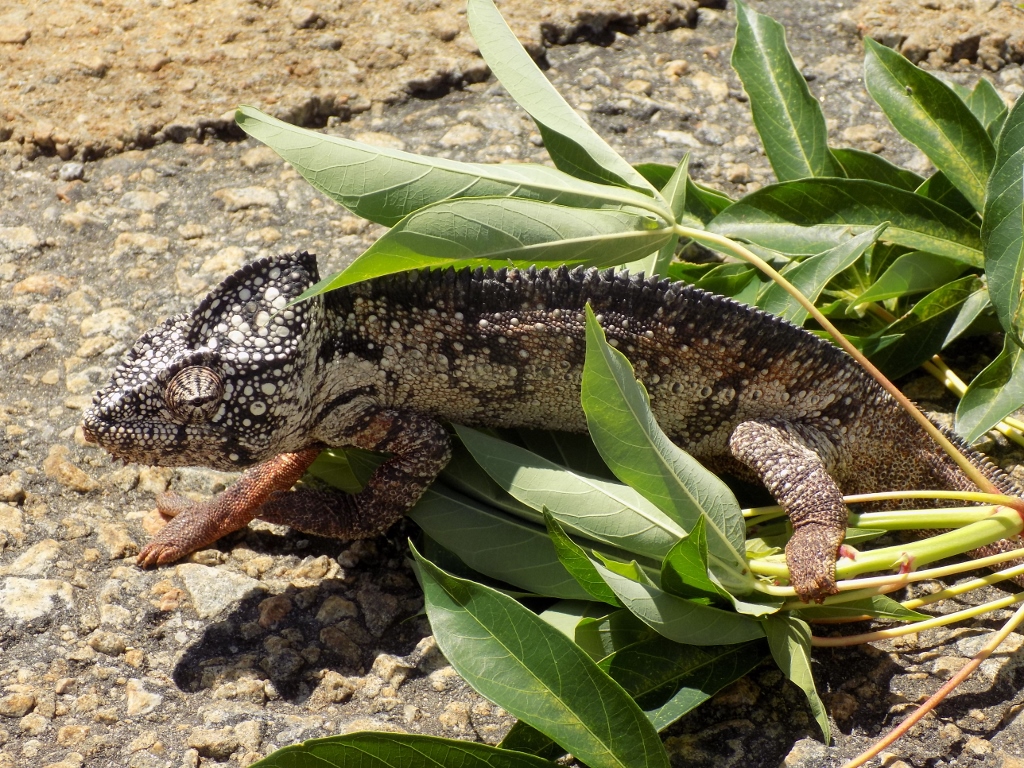 Chameleon on hot asphalt
Chameleon on hot asphalt
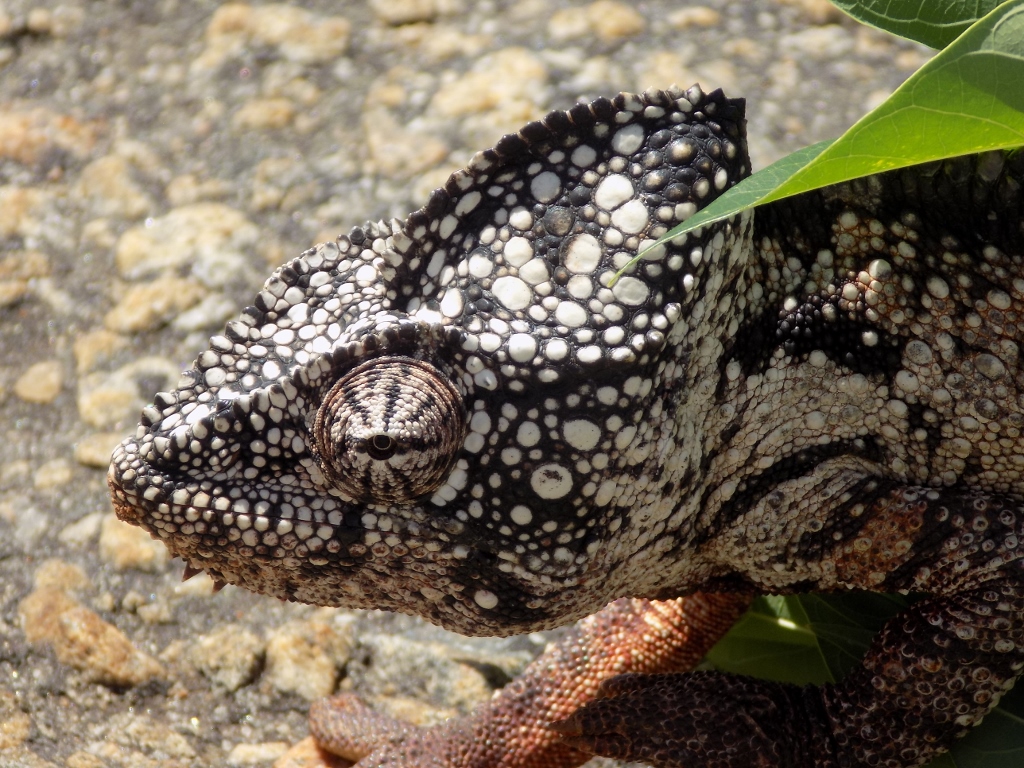 Chameleon on hot asphalt
Chameleon on hot asphalt
As it can be clearly concluded, I immediately jumped at the opportunity (Sneža, too) to take photos of the chameleon, while a couple of women who stayed there kept saying something in Malagasy and in the end it became clear that they were asking if we had “some gifts.” Sneža and I realised they actually wanted some money, so we agreed and gave them a couple of thousand of ariaries, but I also wanted to take photos of them, too. In the meantime, the chameleon took advantage of this confusion and quietly moved away from the road heading towards the vegetation and some new treetop.
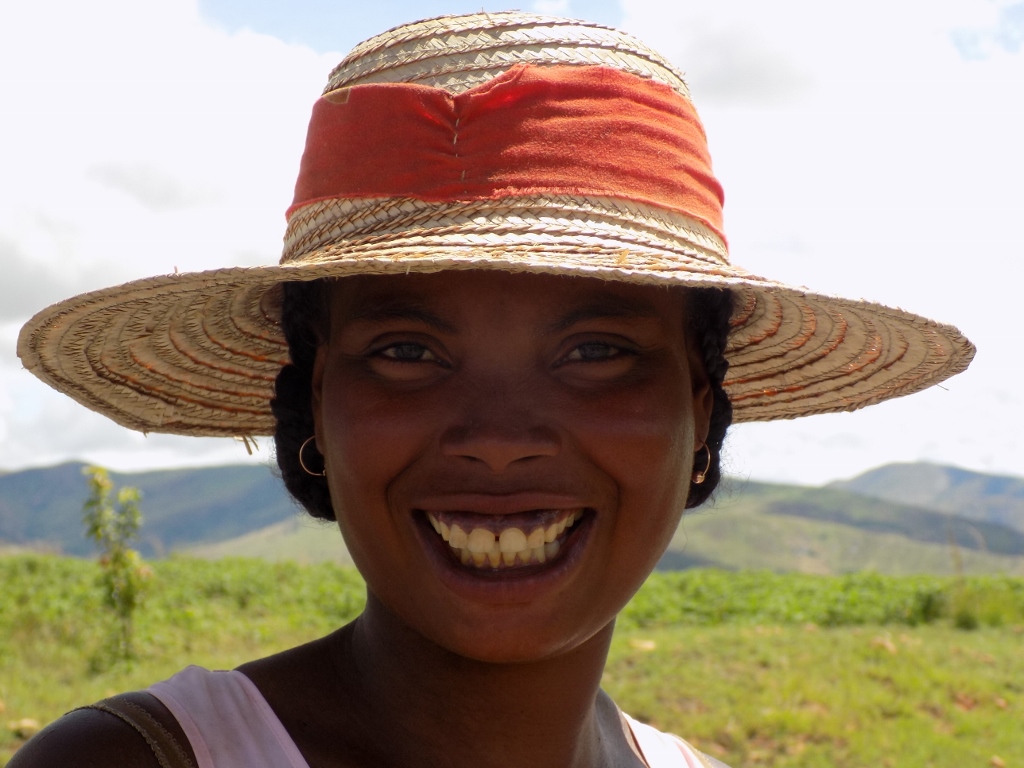 She seems happy with the “gift”...
She seems happy with the “gift”...
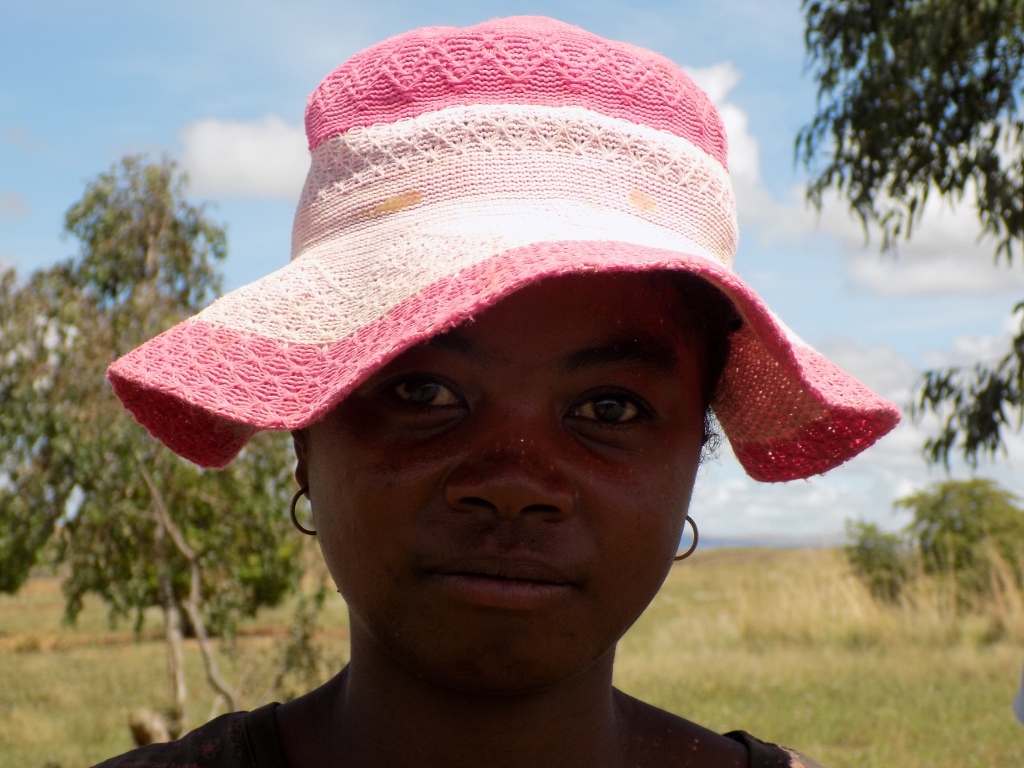 ... this one, not so much
... this one, not so much
After this short break, I focused again on the Ifandana Rock which was in fact the reason why we stopped there in the first place.
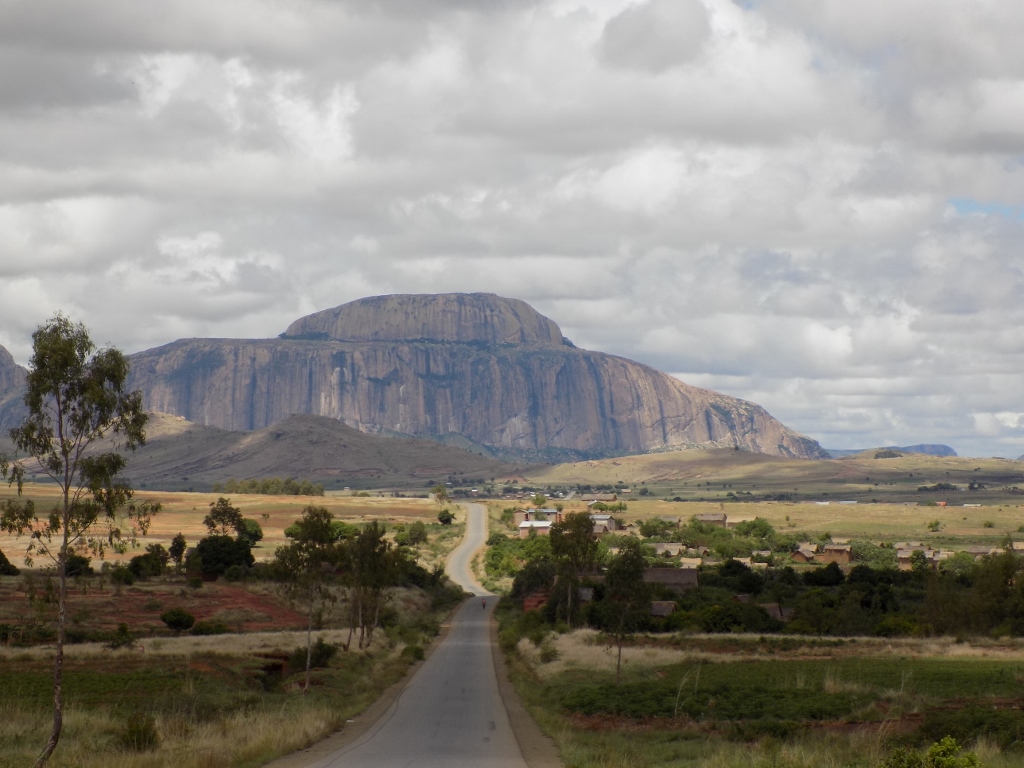 Ifandana Rock
Ifandana Rock
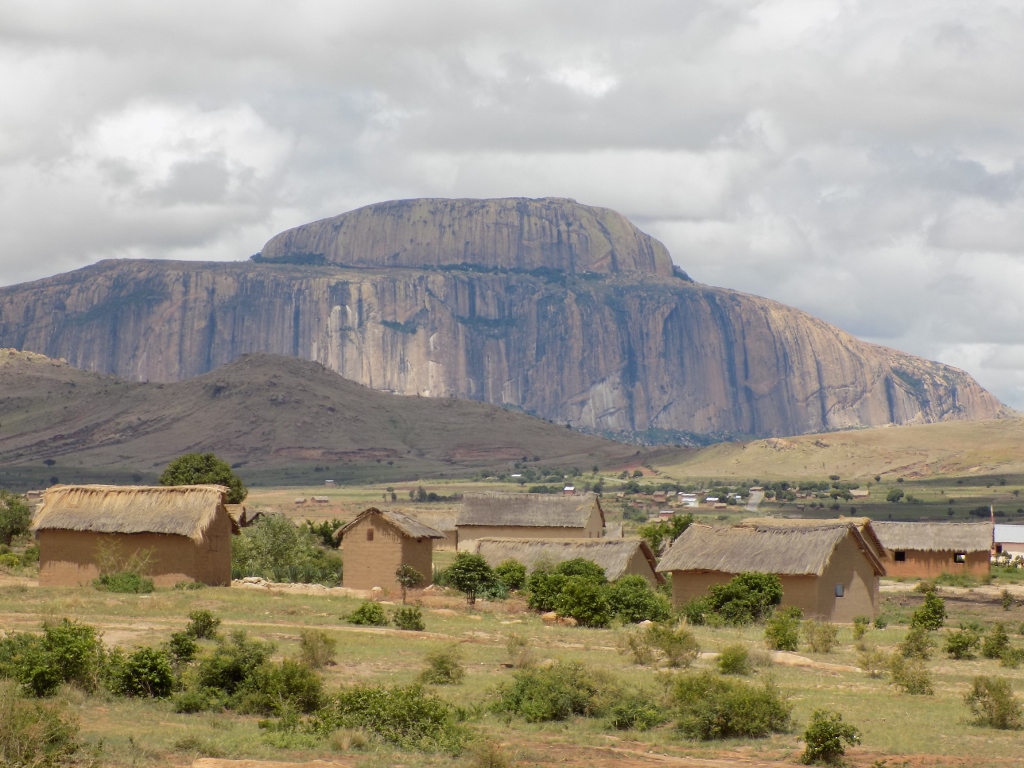 Ifandana Rock and local houses
Ifandana Rock and local houses